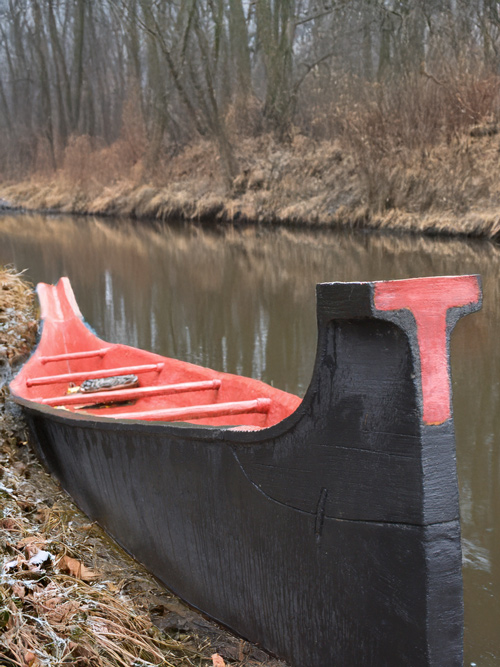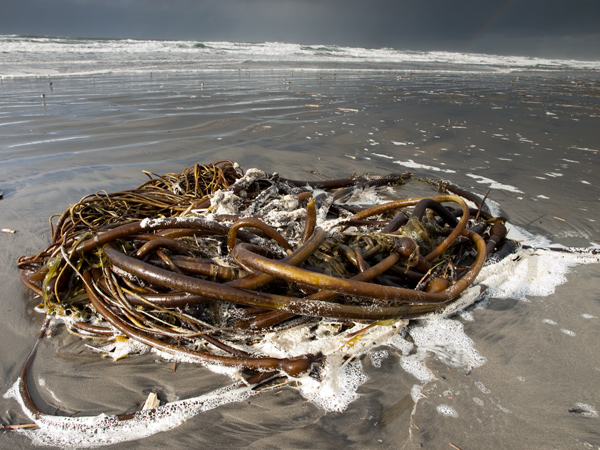Drouillard returns to Fort Clatsop with a Kathlamet canoe purchased with Lewis’s uniform coat. He proposes they take another in lieu of the six elk ‘stolen’ by the Clatsops. Lewis describes seaweed and lists the names of ship captains that anchor in the area.
They Need Canoes
by Yellowstone Public Radio[1]Originally aired weekdays by Yellowstone Public Radio during the Bicentennial observance of 2003-2006. Narrated by Hal Hansen. Scripts by Whit Hansen and Ed Jacobson. Produced by Leni Holliman. © … Continue reading
Chinookan Canoe
This canoe is from an original photo with the creek and forest generated with the assistance of artificial intelligence, © Kristopher K. Townsend 2008 and 2024. Permission to use granted under the Creative Commons Attribution-Share Alike 4.0 International license.
New Kathlamet Canoe
Drewyer returned late this evening from the Cathlahmahs [Kathlamets] with our canoe which Sergt. Pryor had left some days since, and also a canoe which he had purchased from those people. for this canoe he gave my uniform laced coat and nearly half a carrot of tobacco. it seems that nothing excep this coat would induce them to dispose of a canoe which in their mode of traffic is an article of the greatest val[u]e except a wife, with whom it is equal, and is generally given in exchange to the father for his daughter. I think the U’ States are indebted to me another Uniform coat, for that of which I have disposed on this occasion was but little woarn.—
—Meriwether Lewis
A Canoe Conspiracy
We yet want another Canoe as the Clatsops will not Sell us one, a proposition has been made by one of our interpt [Drouillard] and Sever[al] of the party to take one in lieu of 6 Elk which they Stole from us this winter &c.
—William Clark
Trading Ships
The following is a list of the names of the commanders of vessels who visit the entrance of the Columbia river in the spring and autumn fror the purpose of trading with the natives or hunting Elk. these names are spelt as the Indians pronounce them.
Mr. Haley, their favorite trader visits them in a vessel with three masts, and continues some time
—Meriwether Lewis
Vows of Celibacy
Catel and his family left us this morning. Old Delashelwilt and his women still remain they have formed a ca[m]p near the fort and seem to be determined to lay close sege to us but I beleive notwithstanding every effort of their wining graces, the men have preserved their constancy to the vow of celibacy which they made on this occasion to Capt C. and myself.
—Meriwether Lewis
Bull Kelp, Sunset Beach, Oregon
Nereocystis luetkeana
© 20 December 2010 by Kristopher K. Townsend. Permission to use granted under the Creative Commons Attribution-Share Alike 4.0 International license.
Bull Kelp
There are two speceis of the Fuci or seawreck which we also find thrown up by the waves. the 1st speceis at one extremity consists of a large vesicle or hollow vessell which would contain from one to two gallons, of a conic form, the base of which forms the extreem end and is convex and globelar bearing on it’s center some short broad and irregular fibers.
—Meriwether Lewis
Weather Diary
Aspect of the weather at Rise
Wind at rise
Aspect of weather at 4 O’Ck P. M. Wind at 4 OCk. P. M. clouds after rain S. W. rain after fair, hail, snow & rain S W rained all night. air somewhat colder this morning.—frequent and sudden changes in the course of the day.—
—Meriwether Lewis[2]To assist the reader, the editor of this web page has omitted the “Day of the Month” column and spelled out some abbreviations.
Experience the Lewis and Clark Trail
The Lewis and Clark Trail Experience—our sister site at lewisandclark.travel—connects the world to people and places on the Lewis and Clark Trail.
Plan a trip related to March 17, 1806:

Fort Clatsop is a High Potential Historic Site along the Lewis and Clark National Historic Trail managed by the U.S. National Park Service. The site is managed by the Lewis and Clark National and State Historic Parks.
Notes
| ↑1 | Originally aired weekdays by Yellowstone Public Radio during the Bicentennial observance of 2003-2006. Narrated by Hal Hansen. Scripts by Whit Hansen and Ed Jacobson. Produced by Leni Holliman. © 2003 by Yellowstone Public Radio. |
|---|---|
| ↑2 | To assist the reader, the editor of this web page has omitted the “Day of the Month” column and spelled out some abbreviations. |




